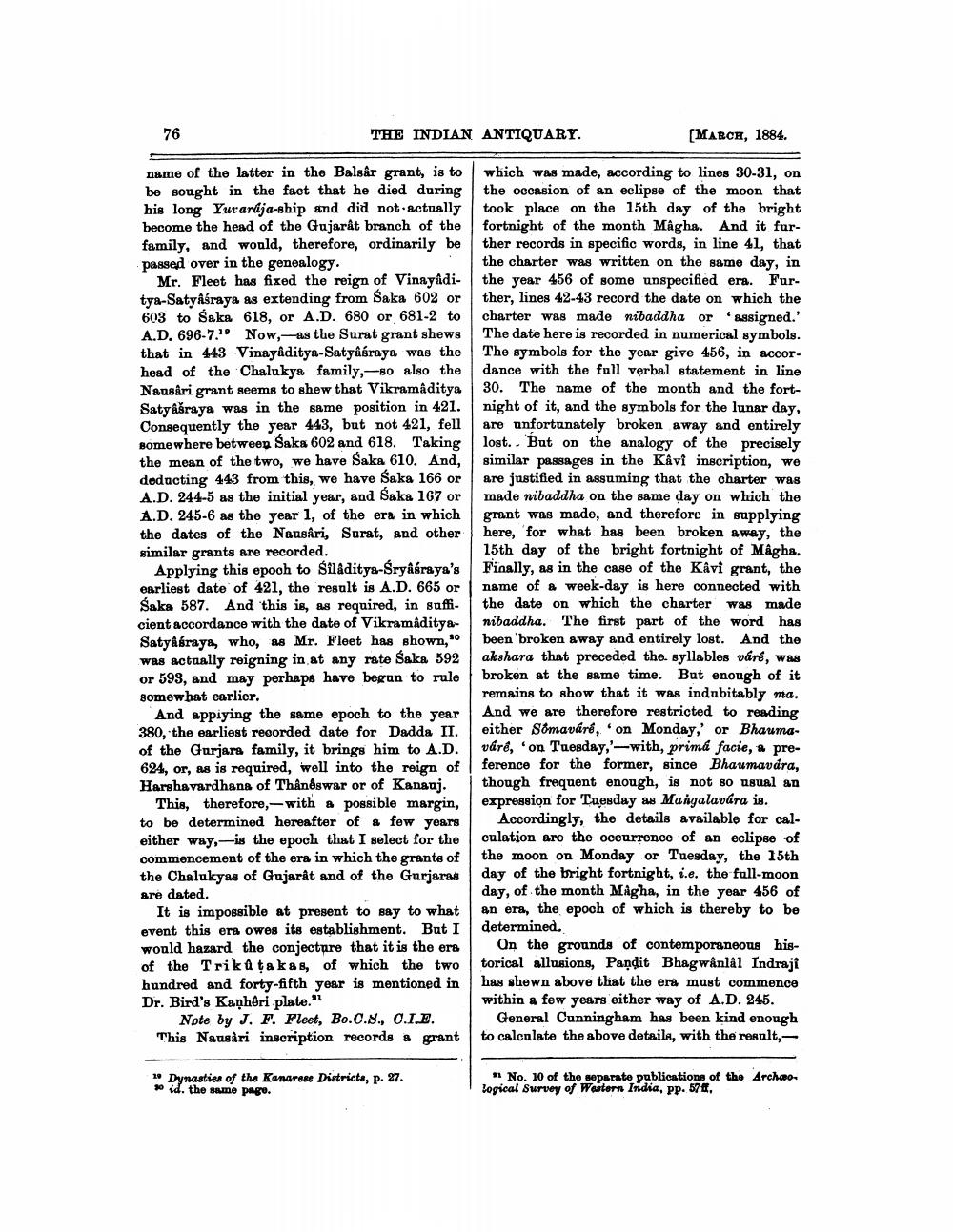________________
76
THE INDIAN ANTIQUARY.
[MARCH, 1884.
name of the latter in the Balsar grant, is to be sought in the fact that he died during his long Yurarája-ship and did not actually become the head of the Gujarat branch of the family, and would, therefore, ordinarily be passed over in the genealogy.
Mr. Fleet has fixed the reign of Vinayaditya-Satyášraya as extending from Saka 602 or 603 to Saka 618, or A.D. 680 or 681-2 to A.D. 696-7.1 Now, as the Surat grant shews that in 443 Vinayaditya-Satyasraya was the head of the Chalukya family,-50 also the Nansiri grant seems to shew that Vikramaditya Satyášraya was in the same position in 421. Consequently the year 443, but not 421, fell somewhere between Saka 602 and 618. Taking the mean of the two, we have Saka 610. And, deducting 443 from this, we have Saka 166 or A.D. 244-5 as the initial year, and Saka 167 or A.D. 245-6 as the year 1, of the era in which the dates of the Nausari, Surat, and other similar grants are recorded.
Applying this epooh to Siladitya-Sryksraya's earliest date of 421, the result is A.D. 665 or Saka 587. And this is, as required, in sufficient accordance with the date of VikramadityaSatyásraya, who, as Mr. Fleet has shown, was actually reigning in at any rate Saka 592 or 593, and may perhaps have began to rule somewhat earlier.
And appiying the same epoch to the year 380, the earliest recorded date for Dadda II. of the Gurjara family, it brings him to A.D. 624, or, as is required, well into the reign of Harshavardhana of Thânêswar or of Kananj.
This, therefore, with a possible margin, to be determined hereafter of a few years either way,-is the epoch that I select for the commencement of the era in which the grants of the Chalukyas of Gujarât and of the Gurjaras are dated.
It is impossible at present to say to what event this era owes its establishment. But I wonld hazard the conjecture that it is the era of the Trika takas, of which the two hundred and forty-fifth year is mentioned in Dr. Bird's Kanhêri plate."
Note by J. F. Fleet, Bo.C.S., O.I.E. This Nausâri inscription records a grant
which was made, according to lines 30-31, on the occasion of an eclipse of the moon that took place on the 15th day of the bright fortnight of the month Magha. And it further records in specific words, in line 41, that the charter was written on the same day, in the year 456 of some unspecified era. Further, lines 42-43 record the date on which the charter was made nibaddha or assigned.' The date here is recorded in numerical symbols. The symbols for the year give 456, in accordance with the full verbal statement in line 30. The name of the month and the fortnight of it, and the symbols for the lunar day, are unfortunately broken away and entirely lost. But on the analogy of the precisely similar passages in the Kåvi inscription, we are justified in assuming that the charter was made nibaddha on the same day on which the grant was made, and therefore in supplying here, for what has been broken away, the 15th day of the bright fortnight of Mâgha. Finally, as in the case of the Kåvi grant, the name of a week-day is here connected with the date on which the charter was made nibaddha. The first part of the word has been broken away and entirely lost. And the akshara that preceded the syllables várt, was broken at the same time. But enough of it remains to show that it was indubitably ma. And we are therefore restricted to reading either Somaváré, on Monday,' or Bhaumaváre, on Tuesday,' --with, prima facie, * preference for the former, since Bhaumavára, though frequent enough, is not so usual an expression for Tuesday as Mangalavára is.
Accordingly, the details available for cal. culation are the occurrence of an eclipse of the moon on Monday or Tuesday, the 15th day of the bright fortnight, i.e. the full-moon day, of the month Magha, in the year 456 of an era, the epoch of which is thereby to be determined.
On the grounds of contemporaneous historical allusions, Pandit Bhagwânlal Indraji has shown above that the era must commence within a few years either way of A.D. 245.
General Cunningham has been kind enough to calculate the above details, with the result, -
* Dynasties of the Kanarese Districta, p. 27. 10 d. the same page.
No. 10 of the separate publications of the Archao. Logical Survey of Western India, Pp. 578.




